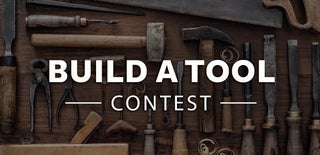Introduction: Wheel Alignment Tool - "BUILD a TOOL" Contest
With the wear of the joints and shocks, the wheel alignment of your vehicle begins wrong.
This can cause a pulling (left or right), premature tire wear, and loss of grip.
The mechanic proceeds to a cure and adjustment with a specific professional device, this operation can be expensive.
To reduce the bill, I suggest you make your own inexpensive and accurate tool. You will find similar tools in the trade like Gunson.
But you will gain to do it yourself.
Step 1: Prerequisites Knowledges
On most popular vehicles, the only adjustment we can make is front wheel alignment.
The constructor gives us positive or negative angular values expressed in degrees.
Example:
Manufacturer's face value for each front wheel of my Austin Mini = - 0.22 °.
This means that each front wheel must be inclined by 0.22 ° with respect to the axis that the vehicle follows while driving (different from the median plane of the vehicle).
- The sign "+" means that the wheel is getting closer to the vehicle, we speak of "pinching".
- The sign "-" means that the wheel moves away from the vehicle, we speak of "opening".
On a classic car, you should know that:
- The rear wheels direct the vehicle => fixed alignment.
- The front wheels adjusts the direction of the vehicle => variable alignment (thanks to the steering wheel).
Step 2: Principle of Tool Operation
The tool made will measure deviation angle, through the lateral displacement of a plate.
Steeringwheel stayed right, the vehicle runs on a free movable plate which can only move laterally.
Important : You have to remove your foot of the throttle pedal and let the vehicle runs free across the plate, otherwise the the measurement may be wrong by the torque of the wheel.
- If the vehicle has "open", the plate will get closer to the vehicle.
- If the vehicle is "pinched", the plate will move away from the vehicle.
After we have just to amplify this displacement (for accuracy), and to transform the translation into rotation (for the angular reading).
Step 3: The Mechanical Study
The measurement accuracy is important, that is why the movements of the parts were studied on a mechanical design software.
I put you here the full drawing folder (PDF and DWG) you need to make your flow.
Attachments
Step 4: The Main Part
After cutting all the elements, I proceeded to assemble the fixed part.
Due to lack of material, I had to make a bolted subassembly to have the correct plate width.
The inclined parts are folded in the vice, which explains the marks and the irregularity of the fold.
Fixing screws may vary depending on what you have available, if necessary you cut them to the necessary length.
Attachments
Step 5: The Roller Cage
I made a rolling tray on the principle of a needle bearing.
The upper mobile plate is supported on free rollers (recovered threaded rods).
They are held by a "cage" made in a plastic sheet plate.
Cutting the notches is not very accurate but at this level no need for precision, the goal is to keep the rollers in place.
Attachments
Step 6: The Reading Arrow
The axis of the boom is a countersunk screw which is tightened from below the base.
The end is adjusted to the length so as not to rub on the underside of the movable platen.
It takes the minimum operating clearance to ensure the most accuracy :
- The hole of the axis of the needle is a diameter of 4 mm for an M4 screw.
- The groove of the needle is 3 mm for the sliding of a screw M3.
Adjust the operating clearance with a file.
Attachments
Step 7: The Mobile Plate
This plate is the part on which the tire will come into contact.
It is very simple, you just have to make a tapping to place the M3 screw that will guide the reading arrow.
We just slide this tray on the fixed part and on the roller cage.
We end up placing the M3 screw that will guide the arrow.
This small screw will be shortened to not rub on the fixed part.
At the end of assembly, we check that the mechanism works perfectly, and that the functional games are correct.
Attachments
Step 8: The Angular Rule
I made a series of measurements on the 3D model, according to the displacement of the moving plate.
I considered that the tire was in contact on 300 mm during the movement of the vehicle.
I calculated the angle of inclination with respect to the lateral displacement of the plate:
angle = ATan (lateral displacement / contact length)
Thanks to the kinematics, I reported the positions of the arrow on the angular rule.
Step 9: Tests and Finishes
Once the tool is assembled, proceed to the tests.
I put here a video made by testing the tool with my Austin Mini.
The tests are conclusive, the repeatability is surprisingly accurate.
It's your turn to work...

Participated in the
Build a Tool Contest













